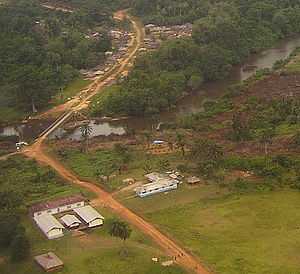Barclayville
| Barclayville | |
|---|---|
 | |
 Barclayville | |
| Coordinates: 4°40′47″N 8°14′2″W / 4.67972°N 8.23389°WCoordinates: 4°40′47″N 8°14′2″W / 4.67972°N 8.23389°W | |
| Country |
|
| County | Grand Kru County |
| Population (2008) | |
| • Total | 2,733 |
Barclayville, the capital and most populous settlement in Grand Kru County is located in southeastern Liberia about 10 miles inland from Picinicess. As of the 2008 national census, the population stood at 2,733.[1] The Barclayville township straddles the banks of the Na River. Roads from Kanweaken to the northwest, Pleebo to the southeast, and to Picinicess and Grand Cess to the southeast, all intersect at Barclayville. In March 2006 the United Nations reported completion of the Na River bridge at Barclayville, connecting the Kanweaken and Pleebo roads for the first time.[2]
The modern jurisdiction of Barclayville was created by President Barclay in response to the last Kru Wars in the 1930s. As part of the effort to exert central government authority and diminish inter-tribal conflicts that resulted in devastation, four separate villages were combined into one township. Until the creation of Barclayville, the constituent villages of Seetor and Kayken, which are from rival chiefdoms, were in periodic conflict. The villages of Seetor, Kayeken and Wakpeken and their "suburbs" are on the northwest side of the Na river while Topor is on the opposite bank across from Wakpekan. Despite the town's large size, most structures are traditional mud and stick homes and(as of mid-1980) few have running water or electricity. Kplio (a dialect of Grebo) is the primary language of all Barclayvillians but English is the official language of instruction.
The regional high school is in Barclayville along with several public and private (Christian) schools for grades K-8. Many religious denominations have churches and/or missions in Barclayville including Catholic, Methodist, Baptist, and a variety of other evangelical congregations, though most of the population also follows local animist practices. Prior to the Liberian Civil War much of the male adult population were on government payroll employed as teachers, employees of the courts, or serving as government officials or their staff. Nevertheless, upland rice farming is the primary occupation. Each village lays claim to large areas of land that extend several miles inland from the town upon which they do slash and burn farming, rotating to a new section of land every year. Because of the distance from the farms to the villages it is common for the women and younger children to live on the farms during the growing season where they establish vegetable gardens and plant cassava. Farming within Barclayville is limited by the presence of freely roaming livestock and fowl including cows, sheep, goats and chickens.
In June 2005 the UN Integrated Regional Information Regional Network reported that the roads leading to Barclayville had decayed and become overgrown by dense bush rendering them impassable.
References
- ↑ "2008 National Population and Housing Census: Preliminary Results". Government of the Republic of Liberia. 2008. Retrieved 2012-03-30.
- ↑ "Ellen Dedicates George Bush Bridge". The Analyst. 27 April 2006. Retrieved 2008-10-20.